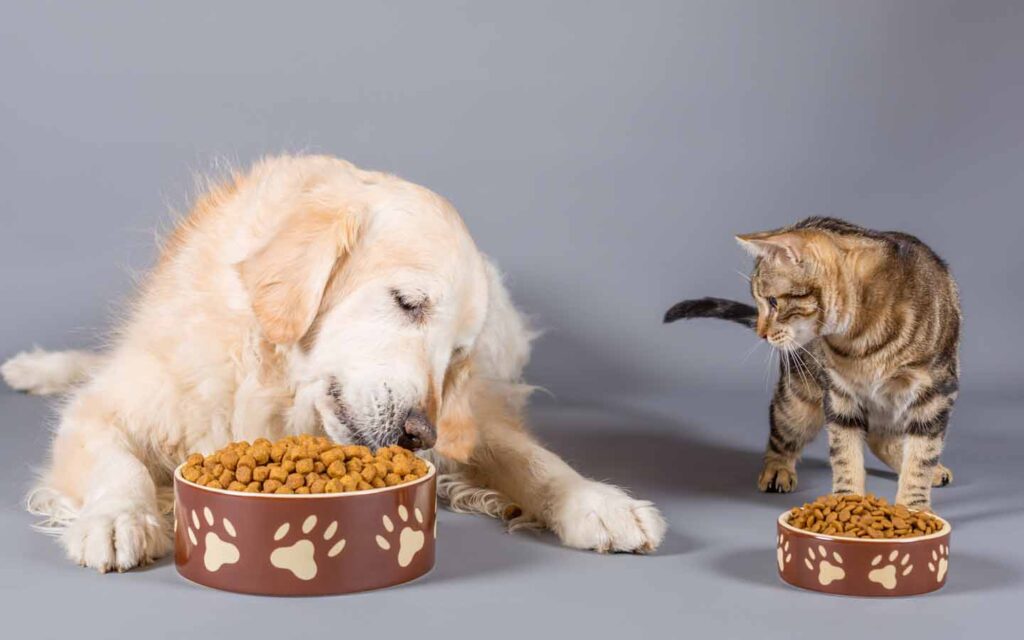By Doug Knueven, DVM, CVC, CVCH
In July of 2018, the FDA released a warning to veterinarians and pet owners regarding a possible link between grain-free dog food and the development of Dilated Cardiomyopathy (DCM). The warning was based on reports from veterinary cardiologists who were seeing a spike in cases of DCM in breeds that are not prone to the disease. The cardiologists further noticed that many of these dogs were being fed grain-free diets – specifically those containing high levels of peas, lentils, legumes or potatoes. Soon the rumor-mill and media took off with the story and the controversy continues to this day.
Before we get into the grain-free issue, let’s back up and look at the disease we’re talking about. DCM is an ailment of the heart muscle brought on by a weakening in the muscle tissue. It is the most common cause of heart disease in certain large-breed dogs such as the Great Dane, Boxer, and Doberman Pinscher. This disease is also linked to a deficiency of the amino acid taurine in a dog’s blood.
The concern with grain-free diets is that they might lead to taurine deficiency. Most caregivers choose grain-free foods because they realize that grains are an unnatural ingredient in a dog’s diet. What they don’t appreciate is that grain-free diets simply replace the grain with ingredients such as peas, lentils, legumes, or potatoes, which are equally inappropriate foods for dogs. In addition, these grain replacers contain anti-nutrients which are natural plant compounds that interfere with the digestion and/or absorption of nutrients such as taurine. So, grain-free dog food manufacturers may formulate their diets to contain adequate taurine, but not account for the amount lost to the anti-nutrients in the diets’ novel components.
The grain-free link to DCM has brought conventional veterinary nutritionists down from their ivory towers and into the media. They are using the concern over grain-free diets to extol the value of grain in dog foods. The mantra of the nutritionists is that, when it comes to pet foods, it’s not the ingredients that are important, but the nutrients. I suppose that they themselves eat “People Chow” rather than freshly prepared meats, vegetables, and fruits.
Pet caregivers are understandably confused. They seem to be forced to choose between foods with crummy ingredients, including gains, with adequate taurine, and dog food with nice looking ingredients that might cause heart disease. Some people have become convinced that corn is good for dogs (which is obviously not true unless you’re talking about corndogs).
For me, this whole grain-free debate is moot. The truth is that no matter how “natural” the ingredients, there is no processed dog food (grain-free or otherwise) that is appropriate for dogs. Dogs have evolved over millions of years to eat a balanced, raw diet such as that of wolves. That’s why their dental structures are nearly identical. A truly natural diet for a dog is free of grains, peas, lentils, legumes, potatoes and other starchy ingredients. It has all the needed taurine and no anti-nutrients.
The importance of a diet’s macronutrient balance (percentages of protein, fat, and carbohydrate) cannot be overstated. Studies show that the macronutrient balance in an animal’s diet affects their grow rate and size, level of obesity, longevity, and disease resistance. If we want healthy pets, we need to feed then their ideal levels of these nutrients. But how can we figure out what’s best?
One way is to look at the diet dogs evolved eating over hundreds of thousands of years. In his book Unlocking the Canine Ancestral Diet, Steve Brown estimates the macronutrient content of the diets of our dogs’ ancestors. From his work I calculated that in the ancestral diet of dogs, approximately 50% of the calories come from protein, 44% comes from fat, and 6% from carbohydrate. This is the kind of diet dogs have adapted to eat.
Multiple research studies show that predators select food based on the macronutrient balance that enhances their survival. From this work it was determined that another way to determine the right balance of macronutrients for dogs is to let them decide.
Recent research looked at the macronutrient profile selection of present-day, adult dogs. They studied 5 diverse breeds including the papillon, miniature schnauzer, cocker spaniel, Labrador retriever and St. Bernard. They found that all these very different dogs consistently chose a diet consisting of 30% protein, 63% fat, and 7% carbohydrate (based on percentage of calories). Now we can quibble over the percentage of fat and protein, but look how close these levels of carbohydrates are to those of Steve Brown’s estimates. According to two, independent studies, the ideal level of carbohydrates for dogs is between 6% and 7%.
Furthermore, the study about dog nutrient profile selection concluded that “…the recent rapid divergence among dog breeds is not substantially reflected in their macronutrient priorities compared with other phenotypic features such as size, color, and temperament.” In other words, our genetic manipulation through breed formation of dogs has not changed their macronutrient selection from that of their ancestors.
So, now we have a good idea of the ideal level of starch in dog food (6-7%). What about processed, dry dog food. The American Association of Feed Control Officials (AAFCO) is responsible for creating the standards for pet foods. According to their recommendations, dog food is acceptable if, as a percentage of calories, there is 19% protein, 12% fat, and 69% carbohydrates. You read that correctly, processed dog food may contain as much as 69% carbs! AAFCO, and the pet food industrial complex, are way out of range. How they can, with a straight face, insist that grains and other sources of carbohydrates are good for pets is beyond me.
Actually, the reason for the excess carbs is clear. It has nothing to do with the healthiness of the food. It is all about keeping the pet food cheap and convenient (you can’t make kibble without starch to glue it together). Cost and convenience are important, but not more important than the health of our pets.
Another problem with processed dog food is that, although the label says it’s “100% complete and balanced,” the experts do not even know the proper levels of all the micronutrients (vitamins and minerals) for dogs and cats. Also, the high heat used to process pet foods create carcinogens. The best diet for most dogs and cats is a balanced raw diet. The brand I like best is called Answers.
So, skip the grain-free debate and go raw!



